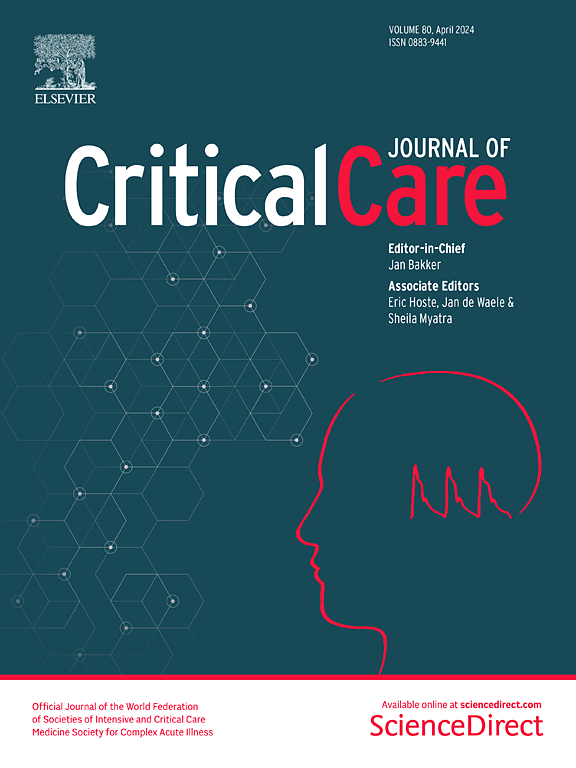The pleural gradient does not reflect the superimposed pressure in patients with class III obesity
IF 8.8
1区 医学
Q1 CRITICAL CARE MEDICINE
引用次数: 0
Abstract
The superimposed pressure is the primary determinant of the pleural pressure gradient. Obesity is associated with elevated end-expiratory esophageal pressure, regardless of lung disease severity, and the superimposed pressure might not be the only determinant of the pleural pressure gradient. The study aims to measure partitioned respiratory mechanics and superimposed pressure in a cohort of patients admitted to the ICU with and without class III obesity (BMI ≥ 40 kg/m2), and to quantify the amount of thoracic adipose tissue and muscle through advanced imaging techniques. This is a single-center observational study including ICU-admitted patients with acute respiratory failure who underwent a chest computed tomography scan within three days before/after esophageal manometry. The superimposed pressure was calculated from lung density and height of the largest axial lung slice. Automated deep-learning pipelines segmented lung parenchyma and quantified thoracic adipose tissue and skeletal muscle. N = 18 participants (50% female, age 60 [30–66] years), with 9 having BMI < 30 and 9 ≥ 40 kg/m2. Groups showed no significant differences in age, sex, clinical severity scores, or mortality. Patients with BMI ≥ 40 exhibited higher esophageal pressure (15.8 ± 2.6 vs. 8.3 ± 4.9 cmH2O, p = 0.001), higher pleural pressure gradient (11.1 ± 4.5 vs. 6.3 ± 4.9 cmH2O, p = 0.04), while superimposed pressure did not differ (6.8 ± 1.1 vs. 6.5 ± 1.5 cmH2O, p = 0.59). Subcutaneous and intrathoracic adipose tissue were significantly higher in subjects with BMI ≥ 40 and correlated positively with esophageal pressure and pleural pressure gradient (p < 0.05). Muscle areas did not differ between groups. In patients with class III obesity, the superimposed pressure does not approximate the pleural pressure gradient, which is higher than in patients with lower BMI. The quantity and distribution of subcutaneous and intrathoracic adiposity also contribute to increased pleural pressure gradients in individuals with BMI ≥ 40. This study introduces a novel physiological concept that provides a solid rationale for tailoring mechanical ventilation in patients with high BMI, where specific guidelines recommendations are lacking.胸膜梯度不能反映 III 级肥胖患者的叠加压力
叠加压是胸膜压力梯度的主要决定因素。无论肺病严重程度如何,肥胖都与呼气末食管压力升高有关,因此叠加压可能不是胸膜压力梯度的唯一决定因素。该研究旨在测量入住重症监护室的患者中存在和不存在 III 级肥胖(体重指数≥ 40 kg/m2)者的分区呼吸力学和叠加压力,并通过先进的成像技术量化胸腔脂肪组织和肌肉的数量。这是一项单中心观察性研究,研究对象包括在食管测压前后三天内接受胸部计算机断层扫描的入住 ICU 的急性呼吸衰竭患者。根据肺密度和最大轴向肺切片的高度计算叠加压力。自动深度学习管道对肺实质进行分割,并对胸部脂肪组织和骨骼肌进行量化。N = 18 名参与者(50% 为女性,年龄为 60 [30-66] 岁),其中 9 人的体重指数小于 30,9 人的体重指数≥ 40 kg/m2。各组在年龄、性别、临床严重程度评分或死亡率方面无明显差异。体重指数≥40的患者食管压力更高(15.8 ± 2.6 vs. 8.3 ± 4.9 cmH2O,p = 0.001),胸膜压力梯度更高(11.1 ± 4.5 vs. 6.3 ± 4.9 cmH2O,p = 0.04),而叠加压力没有差异(6.8 ± 1.1 vs. 6.5 ± 1.5 cmH2O,p = 0.59)。体重指数(BMI)≥ 40 的受试者皮下和胸腔内脂肪组织明显较多,且与食管压力和胸膜压力梯度呈正相关(p < 0.05)。各组之间的肌肉面积没有差异。在 III 级肥胖患者中,叠加压力与胸膜压力梯度并不接近,后者高于 BMI 较低的患者。皮下脂肪和胸腔内脂肪的数量和分布也会导致体重指数≥ 40 的人胸膜压力梯度增加。这项研究提出了一个新的生理学概念,为高体重指数患者的机械通气量身定制提供了可靠的依据,而目前尚缺乏具体的指南建议。
本文章由计算机程序翻译,如有差异,请以英文原文为准。
求助全文
约1分钟内获得全文
求助全文
来源期刊

Critical Care
医学-危重病医学
CiteScore
20.60
自引率
3.30%
发文量
348
审稿时长
1.5 months
期刊介绍:
Critical Care is an esteemed international medical journal that undergoes a rigorous peer-review process to maintain its high quality standards. Its primary objective is to enhance the healthcare services offered to critically ill patients. To achieve this, the journal focuses on gathering, exchanging, disseminating, and endorsing evidence-based information that is highly relevant to intensivists. By doing so, Critical Care seeks to provide a thorough and inclusive examination of the intensive care field.
 求助内容:
求助内容: 应助结果提醒方式:
应助结果提醒方式:


